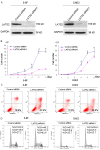LATS2 is de-methylated and overexpressed in nasopharyngeal carcinoma and predicts poor prognosis
- PMID: 20932276
- PMCID: PMC2958949
- DOI: 10.1186/1471-2407-10-538
LATS2 is de-methylated and overexpressed in nasopharyngeal carcinoma and predicts poor prognosis
Abstract
Background: LATS2, which encodes a novel serine/threonine kinase, is known to be important in centrosome duplication and in the maintenance of genomic stability. Recently, a potential role for LATS2 in cancer has been reported. In breast cancer and acute lymphoblastic leukemia (ALL), LATS2 mRNA is downregulated and has been suggested to be a tumor suppressor. However, the role of LATS2 in nasopharyngeal carcinoma has not been investigated. In this study, we aimed to investigate the expression pattern of LATS2 and its clinicopathological involvement in nasopharyngeal carcinoma to understand its effect on cell survival.
Methods: Using quantitative real time PCR and immunoblotting, the expression of LATS2 was detected in nasopharyngeal carcinoma cell lines and in the immortalized nasopharyngeal epithelial cell line NP69. Using immunohistochemistry, we analyzed LATS2 protein expression in 220 nasopharyngeal carcinoma cases. The association of LATS2 protein expression with the clinicopathological characteristics and the prognosis of nasopharyngeal carcinoma were subsequently assessed. Using methylation specific PCR, we detected the methylation status of the LATS2 promoter. RNA interference was performed by transfecting siRNA to specifically knock down LATS2 expression in 5-8F and CNE2.
Results: LATS2 protein was detected in 178 of 220 (80.91%) cases of nasopharyngeal carcinoma. LATS2 overexpression was a significant, independent prognosis predictor (P = 0.037) in nasopharyngeal carcinoma patients. Methylation specific PCR revealed that 36.7% (11/30) of nasopharyngeal carcinoma tissues and all of the chronic nasopharyngeal inflammation samples were methylated. Functional studies showed that the suppression of LATS2 expression in nasopharyngeal carcinoma (5-8F and CNE2) cell lines by using specific small interfering (siRNA) resulted in the inhibition of growth, induction of apoptosis and S-phase cell cycle increase. Overexpression of LATS2 in NP69 stimulated cell proliferation.
Conclusions: Our results indicate that LATS2 might play a role in the tumorigenesis of nasopharyngeal carcinoma by promoting the growth of nasopharyngeal carcinoma cells. Transfection with specific siRNA might be feasible for the inhibition of growth, induction of apoptosis and S phase increase in nasopharyngeal carcinoma.
Figures






Similar articles
-
Overexpression of Wild-Type p53-Induced Phosphatase 1 Confers Poor Prognosis of Patients with Nasopharyngeal Carcinoma.Pathol Oncol Res. 2015 Apr;21(2):283-91. doi: 10.1007/s12253-014-9819-1. Epub 2014 Jul 25. Pathol Oncol Res. 2015. PMID: 25060857
-
Isoliquiritigenin suppresses the proliferation and induced apoptosis via miR-32/LATS2/Wnt in nasopharyngeal carcinoma.Eur J Pharmacol. 2019 Aug 5;856:172352. doi: 10.1016/j.ejphar.2019.04.033. Epub 2019 Apr 17. Eur J Pharmacol. 2019. PMID: 31004603
-
[Inactivation of PMS2 gene by promoter methylation in nasopharyngeal carcinoma].Zhonghua Zhong Liu Za Zhi. 2016 Nov 23;38(11):812-817. doi: 10.3760/cma.j.issn.0253-3766.2016.11.003. Zhonghua Zhong Liu Za Zhi. 2016. PMID: 27998438 Chinese.
-
Promoter Hypermethylation of LATS2 Gene in Oral Squamous Cell Carcinoma (OSCC) Among North Indian Population.Asian Pac J Cancer Prev. 2020 May 1;21(5):1283-1287. doi: 10.31557/APJCP.2020.21.5.1283. Asian Pac J Cancer Prev. 2020. PMID: 32458634 Free PMC article.
-
Hypermethylated LATS2 gene with decreased expression in female breast cancer: A case control study from North India.Gene. 2018 Nov 15;676:156-163. doi: 10.1016/j.gene.2018.07.033. Epub 2018 Jul 17. Gene. 2018. PMID: 30010037
Cited by
-
LATS2 promoter hypermethylation and its effect on gene expression in human breast cancer.Oncol Lett. 2018 Feb;15(2):2595-2603. doi: 10.3892/ol.2017.7535. Epub 2017 Dec 6. Oncol Lett. 2018. PMID: 29434979 Free PMC article.
-
Hippo pathway affects survival of cancer patients: extensive analysis of TCGA data and review of literature.Sci Rep. 2018 Jul 13;8(1):10623. doi: 10.1038/s41598-018-28928-3. Sci Rep. 2018. PMID: 30006603 Free PMC article. Review.
-
Outcome in serous ovarian cancer is not associated with LATS expression.J Cancer Res Clin Oncol. 2019 Nov;145(11):2737-2749. doi: 10.1007/s00432-019-03037-4. Epub 2019 Oct 4. J Cancer Res Clin Oncol. 2019. PMID: 31586262 Free PMC article.
-
miR-363 confers taxane resistance in ovarian cancer by targeting the Hippo pathway member, LATS2.Oncotarget. 2018 Jul 10;9(53):30053-30065. doi: 10.18632/oncotarget.25698. eCollection 2018 Jul 10. Oncotarget. 2018. PMID: 30046387 Free PMC article.
-
The clinical significance and biological function of large tumour suppressor 2 in hepatocellular carcinoma.Cell Prolif. 2017 Jun;50(3):e12340. doi: 10.1111/cpr.12340. Epub 2017 Mar 1. Cell Prolif. 2017. PMID: 28247446 Free PMC article.
References
-
- Airoldi M, Gabriele AM, Garzaro M, Induction chemotherapy with cysplatin and epirubicin followed by radiotherapy and concurrent cysplatin in locally advanced nasopharyngeal carcinoma observed in a non-endemic population. Radiother Oncol. 2009. - PubMed
-
- Chen Y, Liu MZ, Liang SB. et al.Preliminary results of a prospective randomized trial comparing concurrent chemoradiotherapy plus adjuvant chemotherapy with radiotherapy alone in patients with locoregionally advanced nasopharyngeal carcinoma in endemic regions of china. Int J Radiat Oncol Biol Phys. 2008;71:1356–64. - PubMed
Publication types
MeSH terms
Substances
LinkOut - more resources
Full Text Sources

